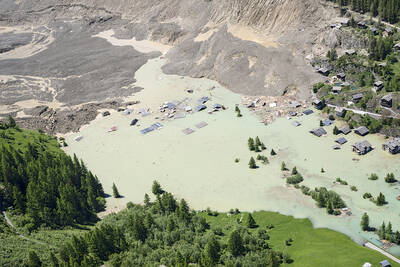Shanghai slowly whirred back to life yesterday as a range of COVID-19 restrictions were eased after a two-month lockdown that confined residents of the Chinese city to their homes and battered the country’s economy.
The commercial hub of 25 million people was closed down in sections from late March, when the Omicron variant of SARS-CoV-2 fueled China’s worst outbreak in two years. After some rules were gradually relaxed over the past few weeks, authorities yesterday began allowing residents in areas deemed low-risk to move around the city freely.
“It feels like we’ve all been through a lot of trauma, a collective trauma,” Grace Guan told Agence France-Presse (AFP).

Photo: AFP
The 35-year-old Shanghai resident said she went out at midnight when the restrictions eased and saw groups gathered in the street drinking beers, some sitting together on blankets laid out on the pavements.
“Now it feels like the Berlin Wall coming down,” she said.
Yesterday morning, commuters trickled into subway stations and office buildings, scanning QR codes that certify they are virus-free.
Residents gathered in small groups to chat in a park, while masked customers thronged one of the main streets in a shopping district.
A day earlier, many of the bright yellow barriers that had hemmed in buildings and city blocks for weeks were taken down.
Shanghai Deputy Mayor Zong Ming (宗明) on Tuesday told reporters that the easing would affect about 22 million people in the city.
Malls, convenience stores, pharmacies and beauty salons would be allowed to operate at 75 percent capacity, while parks and other scenic spots would gradually reopen, she added.
However, cinemas and gyms remain closed, while schools — shut since the middle of March — would slowly reopen on a voluntary basis.
Buses, subway and ferry services would also resume, transport officials said.
Taxi services and private vehicles would be allowed in low-risk areas, permitting people to visit friends and family members outside their district.
“This is a moment that we have been looking forward to for a long time,” the Shanghai City Government said in a statement on social media.
More than 500,000 residents still remained under restrictions as of yesterday, city authorities said.
The stringent curbs in Shanghai — home to the busiest container port in the world — had hammered the economy, starving businesses and snarling supply chains in China and abroad.
Signs of resentment and anger among residents emerged throughout the lockdown.
The city government has warned that the situation is still not normal, and businesses said there were many uncertainties.
“It remains to [be seen] how this new normal will look,” said European Union Chamber of Commerce in China vice president Bettina Schoen-Behanzin, who heads the group’s Shanghai chapter. “If there is a positive case in your office or site, in your compound, what happens? You will be locked down again for two weeks?”
China has persisted with a “zero COVID-19” strategy, which involves rapid lockdowns, mass testing and long quarantines to try to eliminate infections.
However, the economic costs have mounted, and the Shanghai City Government said that “the task of accelerating economic and social recovery is becoming increasingly urgent.”
E-commerce professional Chen Ying said ahead of the easing that she still planned to work from home, but might treat her two-year-old son to a long-awaited walk outside.
“We should have been free to begin with, so don’t expect me to be deeply grateful now they’ve given it back to us,” she told AFP.
While the easing would allow many factories and businesses to resume operations, there are concerns that the recovery would not be immediate.
“I definitely have some worries, things are beyond your control... You can’t tell with a pandemic,” said Chen Ribin, a cafe owner. “No one can tell you if it will come again in July or August... We can only take one step at a time.”

The collapse of the Swiss Birch glacier serves as a chilling warning of the escalating dangers faced by communities worldwide living under the shadow of fragile ice, particularly in Asia, experts said. Footage of the collapse on Wednesday showed a huge cloud of ice and rubble hurtling down the mountainside into the hamlet of Blatten. Swiss Development Cooperation disaster risk reduction adviser Ali Neumann said that while the role of climate change in the case of Blatten “still needs to be investigated,” the wider impacts were clear on the cryosphere — the part of the world covered by frozen water. “Climate change and

Poland is set to hold a presidential runoff election today between two candidates offering starkly different visions for the country’s future. The winner would succeed Polish President Andrzej Duda, a conservative who is finishing his second and final term. The outcome would determine whether Poland embraces a nationalist populist trajectory or pivots more fully toward liberal, pro-European policies. An exit poll by Ipsos would be released when polls close today at 9pm local time, with a margin of error of plus or minus 2 percentage points. Final results are expected tomorrow. Whoever wins can be expected to either help or hinder the

DENIAL: Musk said that the ‘New York Times was lying their ass off,’ after it reported he used so much drugs that he developed bladder problems Elon Musk on Saturday denied a report that he used ketamine and other drugs extensively last year on the US presidential campaign trail. The New York Times on Friday reported that the billionaire adviser to US President Donald Trump used so much ketamine, a powerful anesthetic, that he developed bladder problems. The newspaper said the world’s richest person also took ecstasy and mushrooms, and traveled with a pill box last year, adding that it was not known whether Musk also took drugs while heading the so-called US Department of Government Efficiency (DOGE) after Trump took power in January. In a

It turns out that looming collision between our Milky Way and Andromeda galaxies might not happen after all. Astronomers on Monday said that the probability of the two spiral galaxies colliding is less than previously thought, with a 50-50 chance within the next 10 billion years. That is essentially a coin flip, but still better odds than previous estimates and farther out in time. “As it stands, proclamations of the impending demise of our galaxy seem greatly exaggerated,” the Finnish-led team wrote in a study appearing in Nature Astronomy. While good news for the Milky Way galaxy, the latest forecast might be moot